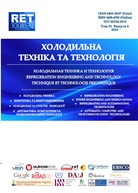FEATURES OF CARBON DIOXIDE AS WORKING SUBSTANCE USEGE IN VAPOR-COMPRESSION REFRIGERATORS. EFFECTIVE CYCLES AND EXPERIENCE OF IN-TRODUCTION IN THE NATIONAL ECONOMY
DOI:
https://doi.org/10.15673/0453-8307.4/2015.39283Keywords:
Refrigerator cycle, Natural refrigerating agents, Carbon dioxide, Refrigerating coefficient, Degree of thermodynamic perfectionAbstract
As working substances of the vapor-compression refrigerators (VCR) it is possible to use various substances. These are specially synthesized connections – freons, and natural coolants – ammonia, carbon dioxide, hydrocarbons. In work the cycles VCR suitable for work on carbon dioxide (R744) are analysed. Subcritical, transcritical, throttle, detander and cascade cycles in which carbon dioxide is applied as coolant of the low temperature contour are considered. Comparison of throttle cycles with various cooling temperature characteristics, one - and two-level compression is given. The short history of the refrigeration units working at CO2 introduction is presented, the list of the producers who are letting out the equipment taking into account features of the studied working substance is provided. Advantages of the cooling systems working at carbon dioxide on the basis of their operation in various European countries experience are shown.
References
Khovalyg D.M., Sinitsina K.M., Baranenko A.V., Tsoi A.P. 2014. Energy efficiency and technological safety technician of low temperatures. Scientific NIO ITMO. Seria “Energy efficiency and ecological safety technicians of low temperatures”, No. 1. [Electron source]. Access mode: http://www.inbt.itmo.ru/articles/1058.pdf. (in Russian).
CO2 refrigeration systems for food shops of retail trade. Transcritical and subcritical systems on CO2 engineering andselection of the necessary equipment produced of the company “Danfoss”. 2009. [[Electron source]. Access mode: www.danfoss.com/CO2.
Tsvetkov O.B. Refrigerants, coolants and refrigerating oil – nostalgia for future. [Electron source]. Access mode: http://holodko.ru/freon/Tsvetkov_Themophys.pdf. (in Russian).
Gorbenko G.A., Chaika I.V., Gakal P.G., Turna R.Yu. 2009. Application of carbon dioxide in refrigerating technologies. Tekhnicheskie Gasy. [Industrial Gases], No. 4, 18-22. (in Russian).
NIST Reference Fluid Thermodynamic and Transport Properties (REFPROP. Version 9.1): [U.S. Department of Commerce]. 2013. National Institute of Standards and Technology. – Gaithersburg, Maryland.
Martynovsky V.S. 1950. Refrigeration units. Moscow: Pishepromiazdat, 256 p. (in Russian).
Martynovsky V.S., Melzer L.Z. 1964. Ship refrigeration units. Moscow: Transport, 383 p. (in Russian).
8. Dossat R.J., Moran T.J. 2001. Principles of Refrigeration. Upper Saddle River. 454 p. ISBN 13: 9780130272706.
Vayshtein V.D., Kantarovich V.I. 1972. Low temperature refrigeration units. Moscow: Pishevaya promishlennost’, 351 p. (in Russian).
Diachenko O.V. 2006. Usage of natural coolants in heat and cool supply of technological process systems. SOK, No. 10, 98-101. (in Russian).
Kharlampidi D.Kh., Sherstuyk A.B., Bratuta E.G. 2011. Thermo dynamic analisis of overcritical cycles of refrigerating machines and heat pumps. Energosnabgenie. Energetika. Energoaudit. [Energy saving. Power engineering. Energy audit], No. 8 (90), 43-48. (in Russian).
[Electron source]. Access mode: http://www.sergey-osetrov.narod.ru/Projects/ Production_of_the_wheat_starch_and_alcohol/ reports.pdf. (in Russian).
[Electron source]. Access mode: http://www.sergey-osetrov.narod.ru/Projects/Production_ of_the_wheat_starch_and_alcohol/reports.pdf. (in Russian).
[[Electron source]. Access mode: www.danfoss.com/NR/ rdonlyres/ 4A74D6CA-C8BA-4F44-BC09-E8CDEC334CFF/1669/ kom_CO3.pdf (in Russian).
[Electron source]. Access mode: http://uash.com.ua/files/bitzer20years.pdf.
[Electron source]. Access mode: www.bitzer.de.
Kozmalov S.N., Bonfanti M. 2014. Usage of Dorin compressors in CO2-technologies. Kholodilnaya Tekhnika, No. 2, 28-31. (in Russian).


